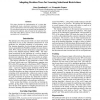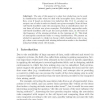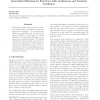FLAIRS
2008
14 years 10 months ago
2008
This paper describes the implementation of a system that automatically learns selectional restrictions for individual senses of polysemous verbs from subject-object relationships....
NLP
2000
14 years 11 months ago
2000
In this article we compare the performance of various machine learning algorithms on the task of constructing word-sense disambiguation rules from data. The distinguishing characte...
AIIA
2003
Springer
14 years 11 months ago
2003
Springer
The aim of this paper is to show how abduction can be used in classification tasks when we deal with incomplete data. Some classifiers, even if based on decision tree induction lik...
IJCNLP
2005
Springer
15 years 1 months ago
2005
Springer
Abstract. Partial parsing techniques try to recover syntactic information efficiently and reliably by sacrificing completeness and depth of analysis. One of the difficulties of pa...
SAC
2009
ACM
15 years 2 months ago
2009
ACM
Decision trees are widely disseminated as an effective solution for classification tasks. Decision tree induction algorithms have some limitations though, due to the typical strat...
ICML
2009
IEEE
15 years 2 months ago
2009
IEEE
The label ranking problem consists of learning a model that maps instances to total orders over a finite set of predefined labels. This paper introduces new methods for label ra...
155
click to vote
CP
2009
Springer
15 years 8 months ago
2009
Springer
Decision tree induction techniques attempt to find small trees that fit a training set of data. This preference for smaller trees, which provides a learning bias, is often justifie...
ICML
2005
IEEE
15 years 8 months ago
2005
IEEE
This paper extends previous work on skewing, an approach to problematic functions in decision tree induction. The previous algorithms were applicable only to functions of binary v...



